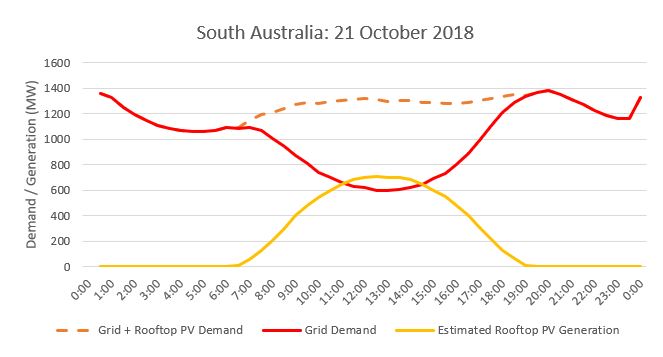Last Sunday there was a new record for minimum grid demand set in South Australia. We know what you’re thinking - what on earth does that mean?
The lowest demands on the electricity grid typically appear overnight when appliances are switched off and air-conditioners aren’t running. Lower demand occurs during what’s referred to as the shoulder season - the time of year when it’s neither excessively hot or cold (effectively autumn and spring).
As the penetration of rooftop solar PV (photovoltaic) grows, it is generating so much electricity during the middle of the day that it’s lowering the demand required by the electricity grid to record levels. The penetration in South Australia is now so high that the state recorded its lowest ever grid demand last Sunday.
Increased electricity generation from rooftop PV is also shifting maximum grid demand from mid-afternoon when it is warmest, and demand is generally highest, to later in the evening by an hour or two, edging ever closer to sunset. What we’re seeing is the traditional models of daytime/night-time as peak/off-peak for grid demand no longer correlating, as lowest demand is not always occurring overnight. Below is how South Australia’s grid demand has changed over the last ten years in October, a low demand month.
As a result of so much rooftop PV generation, quick swings or ramps in the demand required from the grid are becoming bigger and more common. For example, if a large cloud front that blocks the sun moves over a city, demand can go from low to high within minutes. There is now also a significant ramp up in demand in the evenings when the sun sets, reaching a maximum as people return home from work and school. All of these factors are creating a challenge for AEMO’s forecasters, as they work to forecast how much grid demand there will be each day so that the Control Room can bring sufficient flexible generation on line to support the demand.
As penetration of rooftop solar PV continues to increase in every state in Australia, we’ll be working hard to ensure that the grid is operated safely and reliably. To that end, AEMO is collaborating closely with energy market participants, industry partners, stakeholders and consumers to ensure that solar power is an important element in Australia’s future electricity generation fleet.
For example, we are engaging with governments, energy companies and new service providers to work out how existing appliances, such as hot water heaters and pool pumps, together with new smart technologies such as electric vehicles and batteries, can be used to absorb or store electricity from solar generation to help manage the swings and variation that large penetrations of solar roof-top generation can bring.








